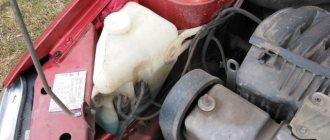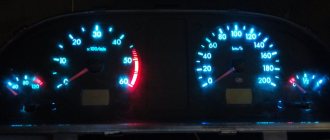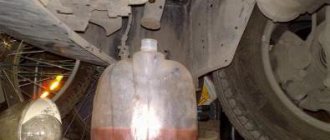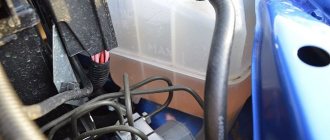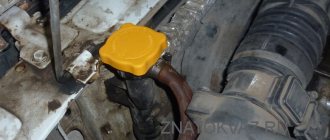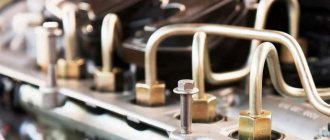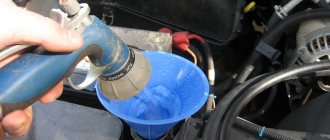Cars admin26.02.2020
How to drain condensate from the gearbox - this question concerns only car owners whose cars have the 1st, 2nd or 3rd generation of gas equipment.
In the 4th generation of gas equipment, there is no drain hole on the gearbox. In injection systems, the reducer pushes out gas under pressure and all liquids along with it. Then it all burns in the cylinders.
The maximum that may be “extra” is resin fractions such as tar. They won't leak anywhere. Something like condensation may accumulate in the gas filter sump. The next time you replace the filter, the “glass” is simply wiped.
Hello! There is a question: is condensate discharged from 4th generation gas equipment? In the 2nd, I know there is, but what about us? and where to look?
How to drain condensate from a gas reducer?
After switching from gasoline to gas, many motorists mistakenly believe that installing LPG is all that is required of them in order to forget about gasoline prices and start really saving. However, it is not. In fact, in order for everything to work properly, it is necessary to regularly monitor the condition of gas equipment and timely replace certain elements.
One of the most important “commandments” when operating gas equipment is the timely replacement of filters and, of course, the timely draining of condensate from the gas reducer. Unfortunately, not everyone knows about this, and some know, but simply ignore this rule.
In this article I will talk about why to drain condensate, when it is necessary to do this work, and also how to do it correctly.
In fact, this important procedure should be performed regularly or after a certain mileage. If you ignore it, then very soon you may have troubles in the form of a decrease in engine power, tripping, or other unpleasant phenomena associated with unstable operation of the power unit.
The most important thing in this matter is not to fall into despair, and not to come up with different versions as to why the engine began to behave this way, that is, in other words, don’t overwhelm yourself. The first step is to check what may be related to the problem, and it is very easy to check. Next, you should remember the rules for operating gas equipment, which the installers should have told you.
Those who installed gas equipment on your car could not help but tell you that you will have to regularly drain the condensate This nuance is very important, so it is unlikely that you were not told about it; most likely, you yourself forgot about it, without attaching much importance to it. This, by the way, also happens, for example, it is also recommended to check the oil in the engine or gearbox regularly, almost every day before leaving, but does anyone do this? Only a few, hardly.
Draining condensate from the gas reducer , as well as checking the oil level, should become a regular occurrence, which you will make it a rule to do once a month or once every two months.
In principle, opinions on how often it is necessary to drain condensate from the gearbox often differ; some say that at least once a month, others say that it is enough to drain condensate every 10 thousand km.
How to drain condensate from a gas reducer?
It is best to clarify this point immediately. After you install LPG on your car, the installer should tell you in detail how and when to perform this procedure.
In order to drain condensate from the gas reducer , you need to prepare a hexagon (at “5” or “6”), a container into which you will drain the condensate, it can be a plastic glass or bottle. You will also need rags and gloves. The smell of this condensate is very strong and very persistent, so you need to do everything carefully so as not to spill a single drop.
Note: When draining condensate, it is recommended to replace the gas filter.
1. Before draining the condensate , it is necessary to warm up the engine to operating temperature.
2. Next, you need to install a container and rags under the gearbox itself (for insurance).
3. Afterwards, you need to unscrew the bolt or faucet; there may also be a plug, in other words, a drain hole specially designed for draining.
4. When the condensation starts to flow, wait until all the “smelly stuff” has drained out and tighten the bolt back. In total, approximately 30 ml of condensate should drain, it all depends on how often you drain the condensate from the gas reducer.
5. After carrying out such a procedure, unfortunately, not all condensate is drained. In order to remove condensation completely, you need to use a little trick. The principle is as follows: a hose of the required diameter (from the medical “system”) is put on the medical syringe. Then the hose is installed in the drain hole and the syringe plunger draws out any remaining condensate.
If you notice that there is a lot of condensate, and you regularly drain it, you should change the gas station; most likely, the quality of gas at this gas station leaves much to be desired.
Source
Maintenance of HBO-2 generations in 15 minutes. — Daewoo Sens, 1.3 l., 2003 on DRIVE2
It's time to service HBO-2.
What should be done:
1. Replace the coarse filter. 2. Drain the condensate from the gearbox.
What you will need for this:
1. 5mm hexagon. 2. 6mm hexagon. 3. New coarse filter. 4. New filter o-rings.
How to do it if you have the popular Tomasetto AT-07 gearbox:
1. tighten the shut-off valve of the flow line on the multivalve. There is only one valve on my multivalve.
2. start the engine and let it run on gas until it stalls. If it stalls, the gas supply from the line is exhausted and the pressure drops.
3. Using a 5mm hexagon, unscrew the three bolts securing the filter cover and remove the cover.
4. Take out the large rubber ring. We see an accumulation of graphite chips. There are two ways to remove it so that graphite does not get into the gearbox.
a) slightly open the flow line valve on the multivalve for a couple of seconds, before removing the filter from the seat. At the same time, you need to make sure that no one smokes or lights fires near the hood. It is unlikely to flare up, but God protects those who are careful.
b) if you have a vacuum cleaner, do it with a vacuum cleaner (that’s what I did)
5. Reassemble in reverse order. We place the small ring, the filter, and the large ring in the groove, and carefully, evenly, but tightly tighten the filter cover with three bolts. Twisting them one by one.
Condensate drain:
1. Lay a rag or place a container under the gearbox. 2. Unscrew the bolt at the very bottom of the gearbox, which is in the same plane as the coolant and gas supply fittings. 3. We wait until it merges. 4. Screw the bolt back in.
Let's check that we haven't forgotten anything. Let's see if we collected everything securely. Smoothly open the valve on the multivalve (if sharply, the high-speed valve may work and emergency shut off the flow) - VOILA, everything is ready.
Let's start the engine and enjoy.
With cover removed
With filter removed.
New and old.
Clogged filter.
I changed my filter 10 thousand ago. The condensate was drained into the first. Less than one cube came out.
www.drive2.ru
Draining condensate from the LPG reducer
During operation of a vehicle with propane gas equipment, gas condensate is formed in the additional fuel system. To remove it, the 4th generation device provides additional filtration (vapor phase filter). In the first modifications of HBO, there is a different scheme for these purposes.
You will learn how to drain condensate from a 2nd generation gas reducer from this article.
Terms of service
Normal and stable operation of gas equipment on a car is possible only with its timely maintenance (maintenance). Manufacturers of 1st, 2nd and 3rd generation gas equipments claim to carry out routine maintenance within 10-15 thousand km. car mileage. Which includes operations such as:
But in reality, it is often necessary to reduce the service interval based on mileage, for several reasons:
If you are not sure of the absence of these reasons, it is recommended to monitor the presence and pour out the oily liquid from the evaporator every 2-3 thousand km. mileage _ In addition, it is important not to forget to remove condensation from the gearbox before preparing the car for winter use.
Why can a gas cylinder on a car explode?
At the end of the work, close the valves on the cylinders. Disconnect the tube. We unscrew the multi-valve from the cylinder and see that the cylinder is completely empty of gas.
No one was injured during the work and no one was poisoned. There was minimal gas smell in the box.
Does each refill of your gas cylinder last for a shorter period of time? Or maybe you noticed a deterioration in the quality of the flame - the burner puffs and goes out from time to time? The reason for this may be condensation that has accumulated in the cylinder after many refills. If you drain it and pump in high-quality gas at a specialized gas station, gas appliances from the cylinder will begin to work no worse than from the central gas pipeline: stably, smoothly and without soot.
In this article we will figure out what gas condensate is, where it comes from in the cylinder, whether it is necessary to get rid of it, and, most importantly, how to drain the condensate from a household gas cylinder yourself.
What condenses in a gas cylinder?
You can often notice that the gas in the cylinder has run out, but something continues to splash at the bottom. Some people think that there is still a little liquefied gas left, but for some reason it does not come out and light up, but this is not so. In fact, after using all the gas, condensate - a residue that does not turn into a gaseous state at room temperature, and therefore does not come out under pressure and does not provide combustion.
To understand why condensation forms in your gas cylinder, let's understand what it consists of.
The liquid that remains at the bottom of the cylinder after all the gas has been used usually consists of several components.
Among them may be:
The amount of such impurities present in the propane-butane mixture and forming condensate directly depends on the quality of the cylinder filling, as well as on the time of year.
Even in cool conditions, both components - propane and butane - actively evaporate, filling under pressure the entire liquid-free space of the cylinder, and are looking for opportunities to escape out
However, there are other petroleum products whose boiling point is much higher: +30 – +90 degrees and higher. That is, when heated to a sufficient temperature, they will behave in the same way as propane and butane - but heating a gas cylinder is very dangerous. And at room temperature, and even at increased pressure inside the cylinder, they remain in a liquid state, forming condensate.
These non-volatile fractions under normal conditions are called gasoline, and the higher the quality of the gas at the gas station, the lower the percentage of their content.
In addition to gasoline, the propane-butane technical mixture that is used to fill household gas cylinders always contains an odorant. This is a special substance, ethyl mercoptane, with an extremely strong pungent odor: it is added in order to notice a leak in time and have time to prevent the accumulation of gas in the room. In addition to the smell of the odorant, you can promptly detect a gas leak and analyze the composition of the gas mixture using special equipment - a gas analyzer.
Without the addition of an odorant, the gas mixture would have no odor - just as neither purified propane, nor pure butane, nor natural gas have any odor. The odorant is also non-flammable, so it remains in the condensate. Its volume is negligible, because according to the norms, 6–9 ml of flavoring is added per 100 kg of liquefied gas. However, after using the cylinder, it almost completely remains in the condensate, due to the decrease in the total mass of substances, its concentration increases.
Drained condensate has a very strong, pungent and persistent odor that does not disappear for quite some time - do not do this in the yard
There should normally be no water or non-flammable impurities in the gas. However, when refueling at untested stations, anything can happen, so we named these components of condensate. Water in a gas cylinder is dangerous because it provokes corrosion of the inner surface of the metal. The inside of the cylinder is not painted, and therefore it rusts easily, and it is impossible to control this process. Such rust is discovered only when it eats through the metal - and this is already too late and extremely dangerous.
Butane is added to household gas cylinders in smaller quantities than propane: in summer their ratio is about 2:3, and in winter – at least 2:8. This is only subject to refueling at a specialized station, and not with automobile gas. As we already mentioned, butane, unlike propane, does not turn into gas at subzero temperatures, so a cylinder installed outdoors may run out sooner than expected.
If you used bottled gas in late autumn or winter, especially if it was filled in the summer, try bringing the bottle indoors after the gas stops supplying. Most likely, after its contents have warmed to room temperature, you will be able to use it for some time.
There is no need to worry about the appearance of condensation on the outside of the cylinder: these droplets of moisture, or even frost, indicate solely the temperature difference between the air and liquid in the cylinder
There is no need to do anything with condensation or frost on the outside of the cylinder; this moisture can only harm the container on which the paint layer is damaged: with prolonged and regular exposure, the steel of the cylinder can begin to rust, and corrosion can lead to a leak, fire and even explosion of the gas cylinder .
However, this will take quite a lot of time, so the user’s task is limited to maintaining uniform and high-quality coloring.
Do-it-yourself 2nd generation HBO maintenance at home
So the summer has passed, the gas equipment installed on the car worked perfectly and without any complaints, but in order for the operation of gas equipment to remain just as flawless with the advent of dampness and cold, it is necessary to carry out a set of maintenance works (MOT) of the gas equipment systems. The article describes the seasonal maintenance of 2nd generation gas equipment, but some of the points given in it are quite suitable for maintenance of other generations.
It is advisable to carry out HBO maintenance before and after cold weather.
Maintenance tools
To carry out maintenance, you need to stock up on the following list of tools:
- screwdriver,
- a set of keys,
- rags
- old plastic bottle, capacity 0.3-0.5 l with a cap,
- silicone grease,
- a filter element with a set of rubber seals for the LPG filter or for the gearbox (if the manufacturer has provided a filter in it),
- fine gasoline filter (if not replaced before autumn).
Before carrying out maintenance of HBO 2, it is necessary that the car engine warms up to an operating temperature of 80-90°C
Draining gas condensate
Gas condensate is a brown oily liquid. Consists of 90% waste oil for lubricating compressors of propane-butane filling stations. The thing smells quite bad, and if it gets on car parts and/or clothing, it eats well and will remind you of itself for a long time with a sharp, unpleasant odor. Since this liquid is oily, when heated it becomes more fluid and, accordingly, drains better from the evaporator reducer.
Draining gas condensate from the reducer involves the following procedure:
- With the engine running on the multivalve, turn the flow valve all the way.
- We wait until the engine, having exhausted the propane-butane mixture from the fuel line and most of the mixture from the evaporator reducer, stalls.
- At this time, we take a pre-prepared plastic bottle with a screwed on cap and cut out something like a “trough” from it - this will be our container for collecting gas condensate from the reducer. In 1-3 generation GBO gearboxes there is a plug at the bottom - a bolt, by unscrewing which you can drain the gas condensate.
- After the engine has stalled, we adapt our container to collect gas condensate under the evaporator gearbox and unscrew the bolt-plug. Even if the bolt plug fell into our container, it’s okay.
- We leave the evaporator reducer with the plug screw turned out until the last drops of gas condensate drain from it.
- After grinding off the liquid, screw the plug-bolt into place to drain the condensate.
Replacing the HBO filter 2
Replacing the gas filter is carried out in parallel with draining the condensate and is an important step that involves servicing the 2nd generation gas equipment.
While the condensate is draining from the gearbox, we will gain access to the LPG filter by unscrewing the 3 screws of the filter cover on the gearbox. When unscrewing these three screws, we will definitely hear a “plop and puff” - this is the remnants of the propane-butane mixture released into the atmosphere, there is no need to worry, this is a normal sound. Having removed the cover, rubber rings and filter, we assess their condition.
The rubber sealing rings must not have tears or other damage and must retain their elasticity and shape. Otherwise, we discard them and replace them with new ones.
We remember the location of the o-rings and filter. It is best to take several photographs, especially if we are doing the gas equipment service for the second time; it is excessive self-confidence that leads to incorrect assembly after maintenance.
By the appearance of the filter element one can indirectly judge the condition:
- HBO cylinder (presence of rusty dust and scale),
- copper gas line (possible presence of black copper decomposition products),
- gas quality at the gas station. If after a run of 5,000 kilometers the filter is completely clogged, you should think about changing the gas station.
Manufacturers recommend changing the 2nd generation LPG filter element once every 10,000 km (its replacement can be combined with changing the engine oil and oil filter).
Remember! Replacing the filter more frequently (in autumn and spring) will not harm the evaporator reducer, but will only extend its service life.
Let's put everything back together in reverse order:
- We treat the rubber seals with a thin layer of silicone grease.
- We install the filter in the reverse order, correctly installing the rubber seals and the filter element.
- Tighten the cover screws in 2 steps.
- We screw the plug-bolt into place to drain the condensate.
By the amount of condensate drained, one can indirectly judge the quality of gas at a gas station. If more than 5 cubic cm of condensate has accumulated during the spring-autumn period, there is a reason to try changing the propane-butane gas station.
Eliminate gas leaks
After the final tightening of all connecting elements, you need to check the quality of the connections and eliminate gas leaks. At home, without the proper equipment, this is done by soaping the joints.
For this:
- Take the detergent and mix it with water until a rich foam forms.
- We apply to the connections and unscrew the supply line valve that we closed earlier until it stops.
- The valves of the supply and filling lines are unscrewed by hand until they stop.
- Turn on the ignition and switch the toggle switch to the “GAS” position.
- We monitor the absence of air bubbles, indicating a leak of the gas mixture.
If we detect the formation of bubbles due to a gas leak, shut off the flow line, eliminate the leak and repeat steps 1-5.
After the work has been done, the HBO system will not present an unpleasant surprise in winter, and the car will work like a clock and continue to please you.
PS In 4th generation LPG, the condensate from the evaporator reducer is not drained. It burns out in the engine. Propane-butane fine filters are simply replaced once every 10,000 km. mileage
HBO maintenance
5 (100%) 2 vote[s]
gbo4auto.ru
Reasons for freezing of the gearbox of gas equipment
When the gearbox freezes, you can see that it is completely covered with white frost or ice. The reasons for this process can be completely different:
Coolant
Causes
A decrease in antifreeze most often leads to freezing of the gas pressure reducer, which can result in plugs in the pipeline. This problem can be identified by the appearance of cold air from the heating radiator.
What to do
This problem can be resolved by simply adding coolant. If you suspect an air lock, you need to disconnect the pipe from the manifold and wait until liquid comes out of it. After this, the tube is installed in its original place.
Water pump
Causes
The water pump is responsible for circulating coolant. If this process stops, then the gearbox freezes. Signs of problems with the pump can be obvious leaks of coolant, which appear due to the gap between the housing and the shaft. In addition, rubber gaskets often fail.
What to do
If the car is equipped with old-style equipment, the car owner has a chance to disassemble the pump and repair it. If the equipment is new, then the pump is not dismountable. In this case, you will have to buy a new one.
Thermostat
Causes
If a breakdown occurs with the thermostat or it is simply jammed, then this may also be the cause of icing of the gearbox, but this problem is very rare. The failure of the thermostat can be indicated by: prolonged warming up of the engine, this happens if the thermostat is stuck in a large circle, or the engine overheats, this is a sign of jamming in a small circle. Problems with the thermostat are also indicated by a rise in the antifreeze temperature when the fan is running and the lower hose is cold.
What to do
This part cannot be repaired and will have to be completely replaced.
Hoses
Causes
Coolant must be pumped through the hoses, and if the hose becomes clogged or for some reason the diameter and length of the hoses are chosen incorrectly, this process may stop completely. An indicator of such problems can be a cold hose for supplying fluid to the gearbox.
What to do
If the diameter of the hoses is correct, then most likely the problem is a blockage. In this case, you need to remove the hoses and see if antifreeze flows from the system. For a more obvious effect, you can “gas” it a little and check the liquid pressure. After cleaning the hoses, you can inspect the thermostat and pump.
Reducer diaphragm
Causes
Failure of rubber diaphragms located in the gearbox is far from a rare occurrence. As a result, gas is directed into the cooling system, which in turn leads to the appearance of white frost on the gearbox itself and partially on the pipes.
What to do
If damage to the diaphragm is confirmed, the problem can only be eliminated by completely replacing it or installing a repair kit.
Solenoid gas valve
Causes
The solenoid itself fails quite rarely, much more often there are breaks in the power contacts or oxidation of the wires. Such a breakdown can be detected by a simple external inspection.
What to do
In this case, the repair is very simple: you need to restore the power by putting the contacts and wires in order.
Gas leak
Causes
The gas system requires constant monitoring of the tightness of all existing connections. The smell of gas coming from under the hood clearly signals problems that have arisen. You can check the tightness by simply washing the connection points.
What to do
This is a very serious problem that requires immediate action to eliminate the leak.
Condensate
Causes
If the car has a second-generation gas system installed, problems may arise due to condensate that has not been drained and completely clogged filters. This problem occurs due to untimely maintenance.
Types and design of valves
The threads of valves for gas cylinders are standardized, but they themselves can have a variety of designs. The choice of valve model is influenced by the type of chemical substance being stored, production features of operation and the amount of money.
Before purchasing new equipment, you should familiarize yourself with the design options and the internal structure of the valves.
Classification of shut-off valves for cylinders
The design features of gas cylinder valves are determined not by the whims of engineers, but by safety considerations.
Gas valve model VB-2. This valve model has proven itself positively back in Soviet times. It has been used in everyday life and industry for decades, causing a minimum of problems.
Depending on the material used, shut-off valves are divided into brass and steel. The choice of metal for the manufacture of the valve body is determined by the type of gases contained in the cylinder.
There are the following types of shut-off valves, depending on the type of chemicals stored:
- Acetylene. The body of such cylinders is painted white. Special valves are used in cylinders containing acetylene, chlorine, ammonia and other aggressive substances.
- Oxygen. The cylinders are painted blue and are intended for storing oxygen, argon, hydrogen, nitrogen, carbon dioxide and other inert gases.
- Propane-butane. They are painted red and are intended for storing substances corresponding to the name and other gaseous hydrocarbons. The most common valve type model for such a cylinder is VB-2.
Valves for acetylene cylinders are not made of brass because the substances they contain may react chemically with copper. Typically, carbon or alloy steel is used to manufacture shut-off valves of this type.
Gas valve device
A standard gas valve has the form of a tee, each fitting of which has an external thread. More advanced models may have an additional protrusion - a safety valve. Its purpose is to relieve excess pressure in the event of a full cylinder heating up or in case of incorrect filling.
The lower fitting of the valve is used to connect to the gas cylinder, the upper one is used to attach the flywheel, and the side one is used to connect communications for gas outlet and injection. The arrangement of the gas cylinder tap is quite simple.
Shut-off valves usually consist of the following general elements:
- Brass or steel body.
- A stuffing box valve or flywheel connected to the body with a union nut.
- Internal locking mechanism with valve and stem.
- Sealing gaskets.
- Plug for the outlet.
You can examine in detail the design of valves on gas cylinders of each type in the presented images.
Image gallery
Photo from
Valve with safety valve
Valve for acetylene cylinder
Valve for oxygen cylinder
Valve for propane-butane cylinder
Worn valves can leak small amounts of gas, which can lead to unpredictable consequences in enclosed spaces. To prevent such situations, a plug is used on the side fitting, which serves for additional sealing of the cylinder during transportation and long-term storage.
The direction of the threads on the outlet holes depends on the chemicals contained in the cylinders: the right is used for non-flammable gases (oxygen, nitrogen, argon, etc.), and the left is used for flammable gases (hydrogen, acetylene, propane, etc.)
The principle of operation of the assembled gas valve is unremarkable. To supply gas and shut it off, simply slowly turn the flywheel in the appropriate direction.
Frequency of draining condensate from the cylinder
But when should condensate be drained? This question is very individual and depends on the quality of the gas being filled and operating conditions.
If you take the cylinders to a specialized gas station, they will inspect them and, if necessary, drain the remainder - you don’t need to do anything
Many users of gas cylinders have not encountered this need at all, while others do this before each refueling. Both of these extremes are normal behavior under certain conditions, and to determine which is closer to you, let’s look at these conditions in more detail.
Option #1 - refueling at a specialized substation
If you fill the cylinder at a specialized substation, you may not encounter condensate at all, for several reasons. Firstly, they fill with the “correct” gas, with a high content of propane, and not just cheap butane, as at car gas stations.
Secondly, their gas quality control is much stricter, so the degree of gas purification is higher, and there are practically no foreign impurities.
Thirdly, at most of these substations, cylinders are exchanged, and before refueling they are inspected and serviced, excessively worn ones are rejected, and after refueling, safety and tightness control is carried out. In particular, substation workers drain condensate if it has accumulated in the cylinder.
Even if you insist on refilling your particular cylinder, it will not be done without first making sure that the unit is in working order and safe. The fact is that specialized substations operate officially, complying with the standards and technical requirements for refilling cylinders, and are responsible for the safety of each client.
Option #2 - refueling at a gas station
Cylinders filled at gas stations, but used for domestic purposes, are much more prone to condensation.
In a car, the gas mixture constantly splashes and mixes in the cylinder without having time to separate into fractions, and modern gas equipment simply sprays condensate into the fuel system along with gas
If a cylinder filled at a gas station is placed at home, all impurities and weakly volatile gases will settle at the bottom and remain there in the form of condensate. Therefore, when refueling with automobile gas, the condensate must be drained at least every 3–4 refuelings, and better before each one.
Separately, we can mention small tourist gas cartridges, up to 1 liter in volume. They have a different outlet, reminiscent of a lighter refill can, and doing anything with it yourself other than using it for its intended purpose is difficult and unsafe. However, many craftsmen refill the cans with their own hands.
Although, in principle, it is more convenient and simpler when such cartridges are filled only at specialized points, with gas of the correct composition and a high degree of purification, so condensation does not form in them. And they are relatively inexpensive, and do not last for decades, like their larger counterparts, so when such a can starts to act up, they usually just buy a new one.
Replacement of HBO filters 4th generation. — Chevrolet Lacetti, 1.8 l., 2008 on DRIVE2
The time has come, and the consumption has increased... I decided to change it on my own, since at the service station this service costs 180 UAH. What such money is for is unclear. There is really one thing - if your LPG is under warranty, replacing the filters yourself will deprive you of it. I will describe the procedure in detail, maybe it will be useful to someone. Gearbox Tomasetto Alaska. On other gearboxes, the filter can be combined with a solenoid valve into one unit and stand separately. Also, a fine filter can be of a more complex design - for example, sediment-type filters.
We buy in the store (I picked it up at the intersection of Kuibyshev St. and Yugoslavskaya St.) two filters and seals - 90 UAH. We drive the car into the garage. Although it is possible on the street. It's even better outside. We climb into the trunk, open the lid on the cylinder, and look for the valve. There may be one, or maybe two (one for refilling, one for dispensing). Shut off the gas supply to the reducer.
The arrow shows the shut-off valve
We climb under the hood. You can immediately replace the fine filter; it is usually easily accessible. We unscrew the clamps, remove the old one, install the new one. There is an arrow on the filter so you don't put it backwards.
Then we climb to the gearbox. I have it in my very…opera, I had to build this crutch to unscrew the filter cover.
The filter on the gearbox is here, under the cover.
Loosen the bolts and release the pressure. There is quite a lot of gas in the line, at least for me. With the cylinder closed, the car can easily travel another couple of kilometers on gas. Therefore, it is better to fit the filter replacement to an empty cylinder, or before disassembling, start it and let the engine produce gas in the line.
I simply bleed by loosening the bolts of the filter cover (open
www.drive2.ru
Instructions for draining condensate
If you neglect the procedure for draining the condensate, less and less gas will be placed in the cylinder each time, and it will not last as long. In addition, by pouring a normal amount of gas mixture into a cylinder where condensation has already accumulated, you risk filling it to capacity, without leaving the required 15% void for the gas cushion. This is extremely dangerous and can cause the cylinder to rupture or explode at the slightest additional heat or shaking.
To prevent undesirable consequences, let's figure out together how to properly clean condensation from a household gas cylinder.
So, the first thing you need to do is use or release the remaining gas.
When releasing gas, be careful: the pressure can be strong, and the cylinder will cool down significantly. Turn the tube away from you and, preferably, while wearing gloves.
If the tile or other equipment is no longer working well from this cylinder and is chugging, you can simply release the gas on the street. To do this, remove the gearbox and gradually open the valve. Under no circumstances do this near a house, fire, wiring, sparks, or in a confined space: a meadow or field where there are no people and the wind will quickly disperse the gas is ideal.
Violating this simple rule can lead to poisoning, fire or explosion - do not risk your health and those around you. Keep in mind that when a large amount of propane-butane passes from a liquid to a gaseous state, the remaining liquid cools down greatly and the cylinder becomes cold.
When the characteristic hissing sound stops when you open the tap, you can say that the gas has run out. That is, it remains only in a gaseous, and not liquid, state, exactly the same volume as the cylinder, so the pressure is not higher than atmospheric, and it does not come out. Most likely, even at this stage, something will splash around in the cylinder - this is condensation.
The reducer, screwed on after the tap, stabilizes and reduces the pressure of the gas leaving the cylinder to operating pressure. It will not drain the condensate
To get rid of condensation, do this:
It is advisable that after this procedure nothing splashes in the balloon. Sometimes you can come across a recommendation to fry empty cylinders in the sun with the valves open in order to remove both remaining condensation and water that may have gotten into the cylinder. But this procedure can be unsafe, especially if you forget to open the valve, and an extra few milliliters of condensate will not make a difference, so it is better not to dry the cylinders unnecessarily.
Due to excess pressure, including that caused by heating in the sun, the cylinder can burst, sometimes even explode, this is dangerous
With proper use, there is nowhere for water to come from, so you will not have to figure out how to properly drain water from a household gas cylinder, and drying is not required.
see also
Comments 24
I have a feeling that the gearbox is clogged up, but I don’t want to get into it. A small dip appeared when starting up a hill (as if it was either not enough or flooded) on the flat, rushing to what I need. I’m thinking of pouring WD 40 into the gearbox for a day through the gas inlet hole. Do you think it will help?
Happens to me too.
Similar Reducer, for 6 years and 200+ thousand I haven’t climbed into it. Filter only
At Euro 4, the condensate flies out under pressure.
in fact - for five years you don’t have to look anywhere... after five years I installed a repair kit on the gearbox and that’s the only reason I took it apart and washed everything inside... I haven’t removed the cylinder for 7 years... or cleaned anything...
There is no condensation in the cylinders on cars with LPG. There is also a gas intake tube at the bottom))))) This is not the grandmothers on the street who have a can in an iron box.)))))
It does not merge on the 4th generation.
what kind of condensate? by 4...
Is he not there? I don't know.
If you submitted the cylinder for testing in a timely manner, you wouldn’t have a headache about condensation and dirt
Once every 2 years it is necessary to pressurize the cylinder.
who's going to pressurize it?))))) it's like a piece of paper about the verification of an LPG - give you 300 rubles immediately stamped))))) Now why should I give my uncle 300 rubles for a piece of paper! It’s the same with a balloon - they’ll take money for air and sit contentedly checking the weather on Mars((((
Safety rules when handling the cylinder
Gas cylinders are extremely dangerous. Every year, dozens and hundreds of household gas cylinders explode, destroying homes and killing people, and in most cases the reason for this is a violation of the rules of their operation.
When filling up gas legally, at a specialized substation, along with a full cylinder, you will receive a reminder on its safe transportation, storage and use. Among other things, it is prohibited to install cylinders closer than half a meter from a gas stove or a meter from a stove, heater or radiator.
It is best to place them in a special metal cabinet with ventilation or under a canopy on the street, near the north wall and away from window and doorways
We also recommend that you read the article: Why gas cylinders explode: the main causes of accidents.
You should not use a winter gas mixture with a high propane content in the summer: it will evaporate too actively, and the cylinder may swell or even burst from excess pressure - and this is with 3 mm thick steel walls.
It is also prohibited to use swollen, dented or damaged cylinders: there is no guarantee that it is sealed and will withstand gas pressure reaching 8 bar.
Natural gas and its benefits
The very name natural speaks about the origin of the gas. It belongs to minerals and consists of the following components:
- methane (70 - 98%);
- heavy hydrocarbons (butane, propane, ethane);
- nitrogen;
- hydrogen;
- helium;
- carbon dioxide;
- hydrogen sulfide.
It is formed in the bowels of the earth in a reservoir state under pressure. It is produced using wells, using the factor of pressure difference in the formation and special equipment that allows collecting the production product. Natural gas is transported through pipelines, using gas carriers, also called tankers, and in railway tanks. A gas tanker is a vehicle that allows the transportation of the extracted product in a liquefied state.
The advantages of natural gas include:
- high calorific value;
- ease of transportation;
- small amount of harmful emissions;
- automation of the combustion process.
It is used for space heating, water heating, cooking in private properties, apartment buildings, public institutions, for heating offices and commercial premises, as fuel for cars, in technological processes for manufacturing products for various purposes.
Conclusions and useful video on the topic
To make sure there are no questions left, we suggest watching a video about how condensate is drained from an empty cylinder:
When using gas cylinders at home, do not forget about the need for their maintenance, because this is a matter of your safety. Draining the condensate and checking the integrity yourself or entrusting it to professionals is up to you, and we told you how to do it effectively and safely.
Do you use gas cylinders and still have condensation after using the gas? Tell us how you get rid of it - the feedback form is located below.
If you have any questions or want to express your opinion about the advisability of draining condensate at home, please join the discussion on the topic.
How often should I drain?
There is no unanimous opinion here. Installers often recommend draining every 2,000 kilometers. However, those who have been driving on gas for a long time believe that it is too much: it is enough to do this after a run of 10,000-20,000 km. Some drivers carry out the procedure every 2 months, others - no more than once a year. However, the time reference is hardly objective. Some put 20,000 on their wheels in a month, others don’t put that much in a year.
on the volume of gas consumed: once you’ve burned 7 cubic meters, it’s time. However, consumption also depends on the distances traveled. Therefore, it seems to us that the figure of 20,000 is the most correct. On the other hand, each owner, having become a little accustomed to the new equipment, knowing how to drain condensate from the gas reducer, and not forgetting to do this, will determine for himself the frequency that suits him most.
Source

